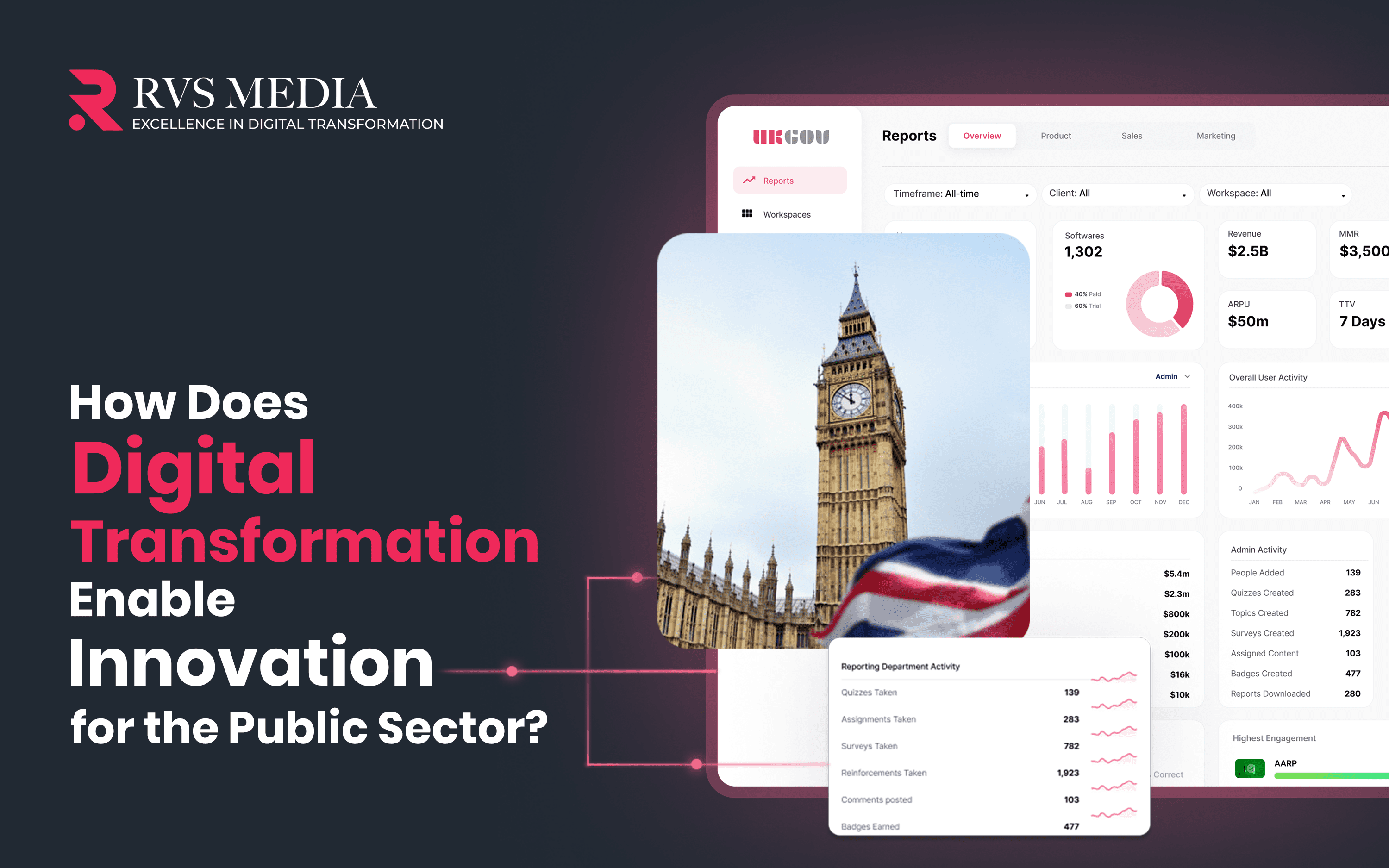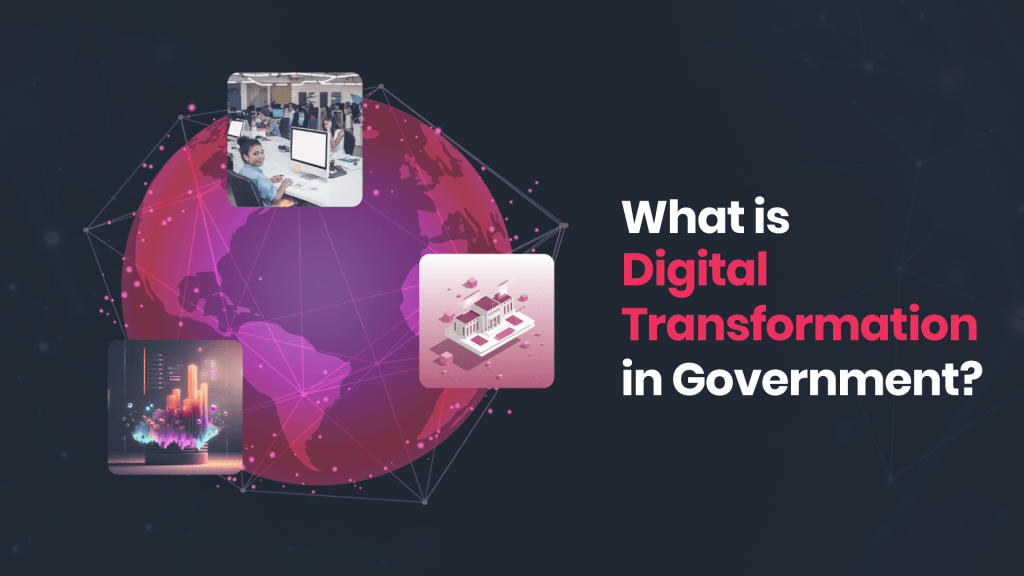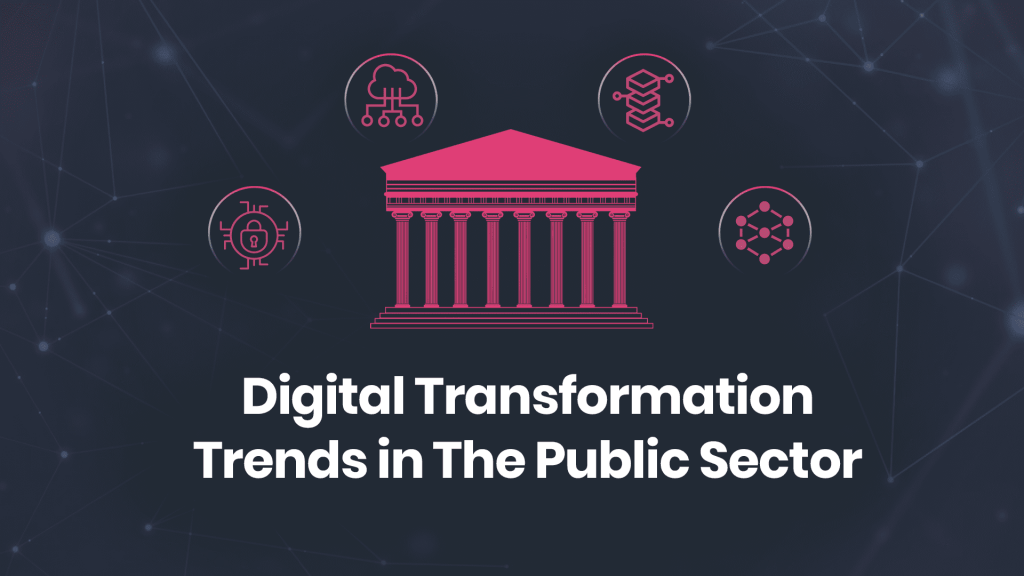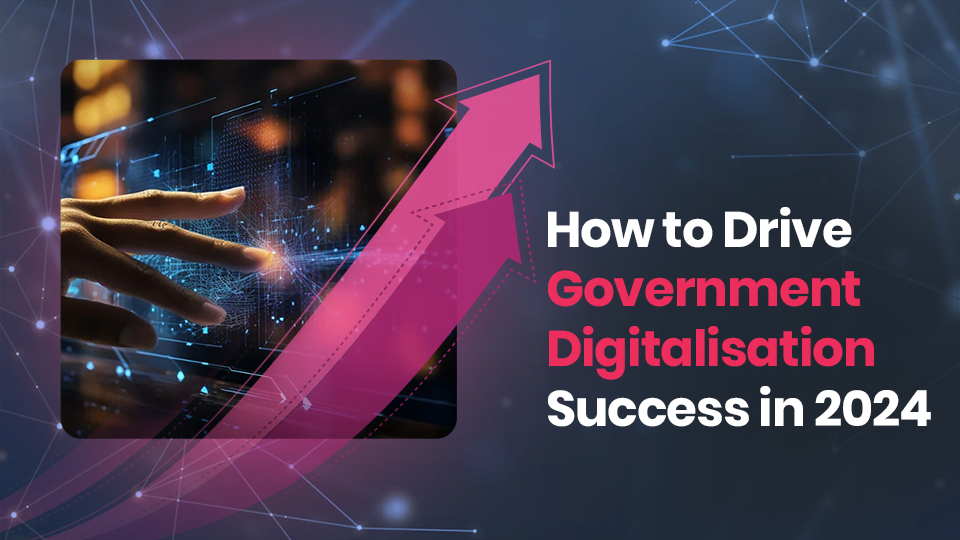How Digital Transformation Enables Innovation for Public sector
- Feb 14, 2024
- By Tanisha Sharma

Introduction:
In today’s rapidly evolving digital landscape, the public sector is undergoing a profound transformation to keep pace with technological advancements and meet the growing expectations of citizens. Digital Transformation Services has become a cornerstone for enabling innovation and enhancing service delivery in government institutions worldwide.
What Is Digital Transformation in Government?

Digital transformation in the government sector refers to the strategic integration of digital technologies to modernise operations, improve service delivery, and enhance citizen engagement. It involves leveraging data analytics, cloud computing, artificial intelligence (AI), and other digital tools to streamline processes and optimise resource allocation.
How is Digital Transformation Impacting the Public Sector?
The impact of digital transformation on the public sector is profound and multifaceted. It has revolutionised the way governments interact with citizens, deliver services, and make policy decisions. By embracing digital technologies, governments can:
- Enhance Citizen Experience: Digital platforms enable citizens to access government services conveniently from anywhere, at any time, fostering a seamless and user-centric experience.
- Improve Efficiency: Automation and digitisation of processes reduce administrative burdens, minimise paperwork, and accelerate service delivery, leading to greater operational efficiency.
- Foster Innovation: Digital transformation encourages experimentation and innovation within government agencies, enabling them to develop new solutions to address complex challenges more effectively.
- Increase Transparency and Accountability: Digital platforms facilitate greater transparency by providing citizens with access to government data and information, thereby enhancing accountability and trust in public institutions.
Benefits of Digital Public Services:
The adoption of digital public services offers a wide range of benefits, including:
- Accessibility: Picture this: no more queues or frustrating waits at government offices. With digital services, citizens can effortlessly access what they need from the comfort of their homes, anytime, anywhere.
- Efficiency: Say goodbye to red tape and bureaucratic delays. Digital processes streamline everything, making transactions smoother and service delivery lightning fast. It’s like cutting through the clutter and getting straight to the good stuff.
- Cost Savings: Think of all the time and money wasted on paperwork and manual tasks. Digitalisation slashes these inefficiencies, saving precious resources and taxpayer dollars. It’s like having a super-efficient assistant who never asks for a raise.
- Personalisation: Imagine a government service tailored specifically to your needs and preferences. With digital platforms, that’s exactly what you get. It’s like having a concierge service that knows you inside out, anticipating your every need.
- Data-Driven Decision Making: Big decisions shouldn’t be based on guesswork. With access to real-time data and analytics, governments can make informed choices that benefit everyone. It’s like having a crystal ball that helps shape a brighter future for all.
Common Examples of Digital Transformation in the Public Sector:
Let’s explore some exciting examples that showcase how digital transformation is reshaping the public sector:
- E-Government Portals: Imagine a one-stop digital hub where you can handle all your government-related tasks without ever leaving your home. From filing taxes to applying for permits and accessing social assistance programs, e-government portals make it all possible with just a few clicks. It’s like having City Hall at your fingertips, open 24/7 for your convenience.
- Digital Identity Solutions: Say goodbye to endless paperwork and frustrating authentication processes. Digital identity platforms allow you to securely access government services and verify your identity online. It’s like having a digital passport that grants you access to a world of government services, hassle-free.
- Smart Cities Initiatives: Picture a city that’s not just smart but genius. With the deployment of IoT sensors and cutting-edge data analytics, governments are transforming urban landscapes to optimise infrastructure, improve transportation systems, and enhance public safety. It’s like living in a city that’s always one step ahead, anticipating your needs and ensuring a seamless urban experience.
- Open Data Platforms: Ever wanted to peek behind the curtain of government data? Open data platforms make it possible. By publishing open datasets, governments empower citizens, businesses, and researchers to access and analyze government data for various purposes. It’s like unlocking a treasure trove of information that fuels innovation, drives decision-making, and fosters transparency.
Digital Transformation Trends in The Public Sector:

Let’s delve into the exciting trends shaping the future of digital transformation services in the public sector:
- AI and Machine Learning: Imagine a government that learns and adapts in real-time. That’s the power of AI and machine learning. Governments worldwide are embracing these technologies to automate processes, make smarter decisions, and deliver services more efficiently. It’s like having a digital assistant that works tirelessly to improve every aspect of government operations.
- Blockchain Technology: Ever wished for a more secure and transparent government? Blockchain technology is making that a reality. Governments are exploring blockchain to revolutionise digital identity management, supply chain transparency, and even voting systems. It’s like having an unbreakable digital ledger that ensures trust and accountability in every transaction.
- Cloud Computing: Picture a government that’s always available, no matter where you are. That’s the promise of cloud computing. By moving to the cloud, governments can scale their infrastructure, store and access data securely, and collaborate seamlessly across agencies. It’s like having a virtual government office that’s open 24/7, ready to serve you whenever you need it.
- Cybersecurity Measures: In a world where digital threats are constantly evolving, cybersecurity is more important than ever. Governments are ramping up their cybersecurity measures to protect sensitive data and critical infrastructure from cyber threats. It’s like building an impenetrable fortress to safeguard the digital foundations of society.
Digital Transformation Challenges Unique to the Public Sector:
Let’s dive into the unique hurdles that the public sector encounters on its digital transformation journey:
- Legacy Systems: Ever tried fitting a square peg into a round hole? That’s the challenge government agencies face when trying to integrate shiny new digital technologies with outdated legacy systems. It’s like trying to teach an old dog new tricks—possible, but definitely not easy.
- Data Privacy and Security: Imagine juggling a dozen balls while walking on a tightrope. That’s what governments have to do when navigating complex data privacy regulations and ensuring robust cybersecurity measures. It’s like safeguarding a treasure trove of sensitive citizen data from an army of digital pirates—no easy feat.
- Digital Skills Gap: In a world where digital skills are as essential as oxygen, the public sector is facing a talent drought. It’s like trying to bake a cake without flour—without skilled professionals proficient in digital technologies, the recipe for successful digital transformation falls flat.
- Resistance to Change: Picture trying to move a mountain with a spoon. That’s the challenge government agencies face when met with bureaucratic inertia and resistance to change. It’s like trying to convince a stubborn mule to change its course—frustrating, but not impossible with the right persuasion.
Considerations for Use in the Public Sector:
To successfully implement digital transformation initiatives in the public sector, several considerations must be taken into account:
Citizen-Centric Approach: Imagine a government that designs its digital services and platforms with you in mind. By prioritizing your needs and preferences, they ensure usability and accessibility are at the forefront. It’s like having a tailor-made suit that fits you perfectly—personalised and comfortable.
Interoperability: Picture a seamless flow of information between different government systems and platforms. By ensuring interoperability and compatibility, data exchange and collaboration become effortless. It’s like speaking the same language with different departments—communication is smooth and efficient.
Data Privacy and Security: Consider the importance of safeguarding your personal data. Governments implement robust measures to protect your information and maintain public trust. It’s like having a fortress guarding your most valuable possessions—secure and reliable.
Stakeholder Engagement: Envision a government that listens and collaborates with citizens, businesses, and other agencies. By fostering engagement, they ensure the success of digital initiatives. It’s like being part of a team where everyone’s voice is heard and valued—empowering and inclusive.
These principles serve as guiding lights in the digital transformation journey, ensuring that government services are not only efficient and effective but also respectful of privacy and responsive to citizen needs.
How to Drive Government Digitalisation Success in 2024?

To drive government digitalisation success in 2024 and beyond, governments should:
- Establish a Clear Vision and Strategy: Just like navigating a ship, governments need a clear direction. By developing a vision and strategy for Digital Transformation Services that aligns with overarching goals, they can chart a course for success. It’s like having a compass that guides every decision, ensuring everyone is heading in the right direction.
- Invest in Digital Infrastructure: Imagine building a skyscraper without a solid foundation. Similarly, governments need to invest in modern digital infrastructure. This includes allocating resources for cloud computing, data analytics, and cybersecurity measures. It’s like laying down sturdy pillars that support innovation and growth, ensuring stability and resilience in the digital realm.
- Foster a Culture of Innovation: Picture a beehive buzzing with activity. Governments can create a similar buzz by fostering a culture of innovation within agencies. This means encouraging experimentation, collaboration, and knowledge sharing. It’s like planting seeds of creativity that blossom into groundbreaking solutions, driving progress and staying ahead of the curve.
- Prioritise Citizen Engagement: Imagine designing a product without considering the end-user’s needs. Similarly, governments must prioritise citizen engagement when designing digital services. By soliciting feedback and incorporating citizen input, they ensure relevance and usability. It’s like co-creating a masterpiece with those who will benefit from it the most, ensuring that everyone’s needs are met and voices are heard.
By following this roadmap, governments can navigate the complex terrain of digital transformation with confidence, ensuring success and delivering tangible benefits to citizens in 2024 and beyond.
Making Digital Transformation Happen – Choose RVS Media
RVS Media stands out as the leading partner for digital transformation in the public sector. What sets us apart is our commitment to delivering tailored solutions that precisely meet the unique needs and challenges of government agencies.
With a deep understanding of digital strategy, technology implementation, and change management, our team of experts ensures that every aspect of the transformation process is meticulously planned and executed. From identifying key objectives to implementing cutting-edge technologies, we work hand-in-hand with government agencies to drive innovation and optimise service delivery.
But our partnership goes beyond just technology. We prioritise the human element, recognizing that successful digital transformation requires not only technological expertise but also effective change management. That’s why we focus on fostering a culture of innovation within government agencies, empowering teams to embrace change and drive continuous improvement.
Together, we’ll not only enhance service delivery but also boost citizen satisfaction, ensuring that every interaction with government services is seamless, efficient, and user-friendly. By choosing RVS Media as your partner, you’re choosing a seamless digital transformation journey that delivers tangible results and makes a lasting impact on the communities you serve.
Wrapping Up:
Digital transformation is reshaping the public sector, enabling governments to deliver more efficient, transparent, and citizen-centric services. By embracing digital technologies and adopting a strategic approach to transformation, governments can unlock new opportunities for innovation and drive positive change in society.
Digital Transformation In Government Sector – FAQs:
Q: What are the key benefits of digital transformation services in the public sector?
A: The key benefits include enhanced citizen experience, improved efficiency, cost savings, personalisation of services, and data-driven decision-making.
Q: What are some common examples of digital transformation initiatives in the public sector?
A: Examples include e-government portals, digital identity solutions, smart cities initiatives, and open data platforms.
Q: What are the main challenges of digital transformation in the public sector?
A: Challenges include legacy systems, data privacy and security concerns, digital skills gap, and resistance to change within government agencies.
Q: How can governments drive digitalisation success in 2024?
A: Governments can drive success by establishing a clear vision and strategy, investing in digital infrastructure, fostering an innovation culture, and prioritizing citizen engagement.
 Shopify
Shopify




















